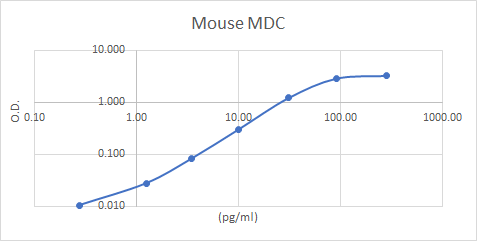Mouse CCL22/MDC Antibody Summary
Gly25-Ser92
Accession # O88430
*Small pack size (-SP) is supplied either lyophilized or as a 0.2 µm filtered solution in PBS.
Applications
Mouse CCL22/MDC Sandwich Immunoassay
Please Note: Optimal dilutions should be determined by each laboratory for each application. General Protocols are available in the Technical Information section on our website.
Scientific Data
 View Larger
View Larger
Chemotaxis Induced by CCL22/MDC and Neutralization by Mouse CCL22/MDC Antibody. Mouse CCL22/MDC Antibody (Catalog # MAB4391) neutralizes CCL22/MDC-induced chemotaxis in the BaF3 mouse pro-B cell line transfected with human CCR4. The Neutralization Dose (ND50) is typically 1.00 - 12.0 μg/mL in the presence of 10.0 ng/mL Recombinant Mouse CCL22/MDC.
Reconstitution Calculator
Preparation and Storage
- 12 months from date of receipt, -20 to -70 °C as supplied.
- 1 month, 2 to 8 °C under sterile conditions after reconstitution.
- 6 months, -20 to -70 °C under sterile conditions after reconstitution.
Background: CCL22/MDC
CCL22, also known as ABCD-1 and MDC (macrophage-derived chemokine), is a CC chemokine cloned from activated mouse B cells. Mouse CCL22 cDNA encodes a precursor protein of 92 amino acid (aa) residues with a 24 aa residue predicted signal peptide that is cleaved to yield a 68 aa residue mature 7.8 kDa protein. At the amino acid sequence level, mouse and human CCL22 share 64% identity and 83% similarity. The genomic organization of the mouse and human CCL22 genes are very similar, exhibiting sequence identity at the intron-exon boundaries. Mouse CCL22 is expressed at high levels in dendritic cells and activated B lymphocytes. Low levels of mouse CCL22 mRNA are also detectable in lung, unstimulated spleen cells, lymph node cells and in thymocytes. CCL22 is a functional ligand for the CC chemokine receptor 4. Recombinant or chemically synthesized mature mouse CCL22 has been shown to induce chemotaxis or Ca2+ mobilization in activated mouse and human T cells.
- Schaniel, C. et al. (1998) J. Exp. Med. 188:451.
- Imai, T. et al. (1998) J. Biol. Chem. 273:1764.
- Godiska, R. et al. (1997) J. Exp. Med. 185:1595.
- Chang, M-S. et al. (1997) J. Biol. Chem. 272:25229.
Product Datasheets
Citations for Mouse CCL22/MDC Antibody
R&D Systems personnel manually curate a database that contains references using R&D Systems products. The data collected includes not only links to publications in PubMed, but also provides information about sample types, species, and experimental conditions.
6
Citations: Showing 1 - 6
Filter your results:
Filter by:
-
Ccl22 Diverts T Regulatory Cells and Controls the Growth of Melanoma
Authors: Jared Klarquist, Kristen Tobin, Peyman Farhangi Farhangi Oskuei, Steven W. Henning, Manuel F. Fernandez, Emilia R. Dellacecca et al.
Cancer Research
-
CCL22-specific Antibodies Reveal That Engagement of Two Distinct Binding Domains on CCL22 Is Required for CCR4-mediated Function
Authors: Sandra Santulli-Marotto, John Wheeler, Eilyn R. Lacy, Ken Boakye, Jennifer Luongo, Sheng-Jiun Wu et al.
Monoclonal Antibodies in Immunodiagnosis and Immunotherapy
-
Response patterns of cytokines/chemokines in two murine strains after irradiation.
Authors: Zhang M, Yin L, Zhang K, Sun W, Yang S, Zhang B, Salzman P, Wang W, Liu C, Vidyasagar S, Zhang L, Ju S, Okunieff P, Zhang L
Cytokine, 2012-01-25;58(2):169-77.
Species: Mouse
Sample Types: Plasma
Applications: Luminex Development -
Resolution of allergic inflammation and airway hyperreactivity is dependent upon disruption of the T1/ST2-IL-33 pathway.
Authors: Kearley J, Buckland KF, Mathie SA, Lloyd CM
Am. J. Respir. Crit. Care Med., 2009-01-29;179(9):772-81.
Species: Mouse
Sample Types: Cell Culture Supernates
Applications: ELISA Development -
CD4+CD25+ regulatory T cells reverse established allergic airway inflammation and prevent airway remodeling.
Authors: Kearley J, Robinson DS, Lloyd CM
J. Allergy Clin. Immunol., 2008-07-30;122(3):617-24.e6.
Species: Mouse
Sample Types: BALF
Applications: ELISA Development -
iNKT cells require CCR4 to localize to the airways and to induce airway hyperreactivity.
Authors: Meyer EH, Wurbel MA, Staton TL, Pichavant M, Kan MJ, Savage PB, DeKruyff RH, Butcher EC, Campbell JJ, Umetsu DT
J. Immunol., 2007-10-01;179(7):4661-71.
Species: Mouse
Sample Types: Whole Cells
Applications: Neutralization
FAQs
No product specific FAQs exist for this product, however you may
View all Antibody FAQsReviews for Mouse CCL22/MDC Antibody
Average Rating: 5 (Based on 1 Review)
Have you used Mouse CCL22/MDC Antibody?
Submit a review and receive an Amazon gift card.
$25/€18/£15/$25CAN/¥75 Yuan/¥2500 Yen for a review with an image
$10/€7/£6/$10 CAD/¥70 Yuan/¥1110 Yen for a review without an image
Filter by:



